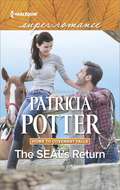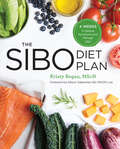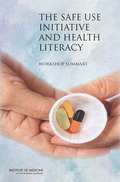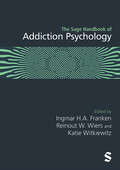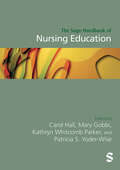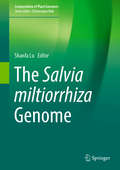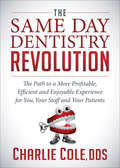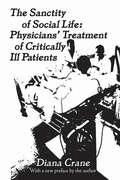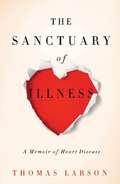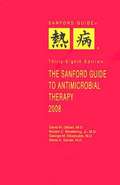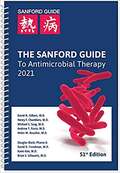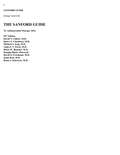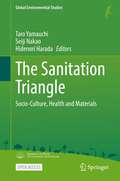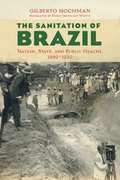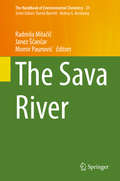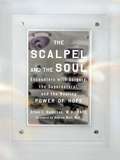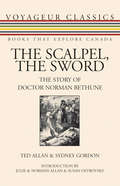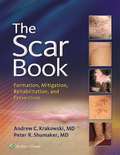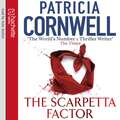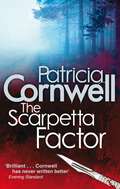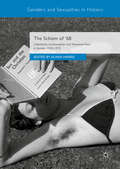- Table View
- List View
The SEAL's Return
by Patricia PotterThis is the home he never expected... With a terrifying ordeal behind him, former navy SEAL Jubal Pierce was supposed to stay in Covenant Falls, Colorado, for only a day or two. That's it. He's not prepared to put down roots here-no matter how intriguing the town's new doctor happens to be. Not to mention Dr. Lisa Redding's teen brother is on a troubled path that's all too familiar. Suddenly Jubal finds himself entangled in the community and with deep, unfamiliar feelings for Lisa. But maybe a little detour is just what a warrior needs to find his true purpose...and true love.
The SIBO Diet Plan: Four Weeks to Relieve Symptoms and Manage SIBO
by Kristy ReganRelief from SIBO is here—a 4 week diet plan for managing symptoms.The key to SIBO symptom relief is a commitment to a SIBO-friendly diet. Specifically designed to jump-start good health, The SIBO Diet Plan equips you with an actionable meal plan and follow-up recipes to change your diet and manage symptoms.Over the course of 4-weeks, this modified low-fodmap diet progressively builds your tolerance from easily digestible foods to a more diverse range of ingredients. With week-by-week guidance that includes a meal schedule, shopping lists, and tips for meal prep, you will reset your system and begin to heal your gut.Based on the most up-to-date research, The SIBO Diet Plan lays the groundwork for a SIBO-friendly diet with:A 30-Day SIBO Meal Plan that removes the stress of dietary change with planned meals, shopping lists, meal prep advice, and delicious recipesA SIBO Overview that teaches you everything you need to know about SIBO, including why it's so hard to diagnose and what symptoms to watch out forOver 90 Delicious Recipes that serve you with plenty of variety for breakfast, lunch, and dinner, so that you stick to a SIBO sensitive diet long after the meal plan is overTake control of your symptoms and start to heal in 4-weeks with The SIBO Diet Plan.
The Safe Use Initiative and Health Literacy: Workshop Summary
by Institute of Medicine of the National AcademiesEvery year at least 1.5 million people suffer adverse effects from medication. These problems occur because people misunderstand labels, are unaware of drug interactions, or otherwise use medication improperly. The Food and Drug Administration's Safe Use Initiative seeks to identify preventable medication risks and develop solutions to them. The IOM held a workshop to discuss the FDA's Safe Use Initiative and other efforts to improve drug labeling and safety.
The Sage Handbook of Addiction Psychology
by Katie Witkiewitz Reinout W. Wiers Ingmar H.A. FrankenThe Sage Handbook of Addiction Psychology presents a comprehensive overview of the state of the science behind the psychology of addiction, offering a crucial resource for psychologists engaged in both research and practice. The Handbook features a distinguished international group of contributors, all renowned specialists in their respective fields and emphasizes a forward-looking perspective. Chapters delve into psychological theories of addiction and evidence-based addiction treatment, offering practical insights on the intricacies of addiction psychology. The handbook takes a holistic approach by incorporating neighbouring fields traditionally outside of psychology; it explores economics, genetics, public health, neurobiology, computer science, and sociology, recognizing that psychology and individual-centered perspectives are just one facet of addiction. This multifaceted approach ensures that readers gain a broad understanding of the psychology of addiction, fostering a comprehensive and nuanced comprehension of this complex subject. With Substance Use Disorders ranking among the most prevalent mental health concerns globally, this handbook, designed from the ground up for students and researchers, is an essential resource for those seeking a deep understanding of the field of addiction psychology. Part 1. Background, including history and epidemiology. PART 2. Vulnerability, including psychological, environmental, and biological factors. PART 3 Interventions PART 4 Specific addictions PART 5 Future directions
The Sage Handbook of Addiction Psychology
by Katie Witkiewitz Reinout W. Wiers Ingmar H.A. FrankenThe Sage Handbook of Addiction Psychology presents a comprehensive overview of the state of the science behind the psychology of addiction, offering a crucial resource for psychologists engaged in both research and practice. The Handbook features a distinguished international group of contributors, all renowned specialists in their respective fields and emphasizes a forward-looking perspective. Chapters delve into psychological theories of addiction and evidence-based addiction treatment, offering practical insights on the intricacies of addiction psychology. The handbook takes a holistic approach by incorporating neighbouring fields traditionally outside of psychology; it explores economics, genetics, public health, neurobiology, computer science, and sociology, recognizing that psychology and individual-centered perspectives are just one facet of addiction. This multifaceted approach ensures that readers gain a broad understanding of the psychology of addiction, fostering a comprehensive and nuanced comprehension of this complex subject. With Substance Use Disorders ranking among the most prevalent mental health concerns globally, this handbook, designed from the ground up for students and researchers, is an essential resource for those seeking a deep understanding of the field of addiction psychology. Part 1. Background, including history and epidemiology. PART 2. Vulnerability, including psychological, environmental, and biological factors. PART 3 Interventions PART 4 Specific addictions PART 5 Future directions
The Sage Handbook of Nursing Education
by Carol Hall Patricia S. Yoder-Wise Mary Gobbi Kathryn Whitcomb ParkerIn the past several years, a revival of research devoted to nursing education has emerged. This emergence has changed the way many educators engage in their practice of working with learners; and learners have come to expect that they will have a rich learning experience designed to develop new (or enhance prior) knowledge, skills, and attitudes. The SAGE Handbook of Nursing Education provides a detailed map of the current discipline, with a carefully selected team of international contributors offering the latest thinking about education in nursing across key areas. This handbook will be a key resource for academic educators, as well as graduate and postgraduate learners.
The Sage Handbook of Nursing Education
by Carol Hall Patricia S. Yoder-Wise Mary Gobbi Kathryn Whitcomb ParkerIn the past several years, a revival of research devoted to nursing education has emerged. This emergence has changed the way many educators engage in their practice of working with learners; and learners have come to expect that they will have a rich learning experience designed to develop new (or enhance prior) knowledge, skills, and attitudes. The SAGE Handbook of Nursing Education provides a detailed map of the current discipline, with a carefully selected team of international contributors offering the latest thinking about education in nursing across key areas. This handbook will be a key resource for academic educators, as well as graduate and postgraduate learners.
The Salvia miltiorrhiza Genome (Compendium of Plant Genomes)
by Shanfa LuThis is the first book on the genome of Salvia miltiorrhiza, summarizing the research advances in the molecular mapping, whole genome sequencing, chloroplast and mitochondria genomes, epigenetics, transcriptomics and functional genomics of this emerging model plant with great economic and medicinal value. It also describes its distribution, taxonomy and morphology and provides useful information on its cultivation and breeding. Further, it highlights the biosynthetic pathways of tanshinones and phenolic acids – two main classes of bioactive components produced in this plant species – and reviews and discusses the technology of hairy root induction, tissue culture and genetic transformation of S. miltiorrhiza.The book is a valuable resource for students, teachers and researchers in academia and industry interested in medicinal plants and pharmacy.
The Same Day Dentistry Revolution: The Path to a More Profitable, Efficient and Enjoyable Experience for You, Your Staff and Your Patients
by Charlie ColeThe current model of practicing dentistry is like a bad tooth in sore need of extraction. In The Same Day Dentistry, Charles Cole D.D.S. shows us the path to a better way of practicing dentistry – one that gives patients solutions the same day rather than “someday.” It also shows how one dentist’s personal journey can translate to a rewarding career for anyone willing to read, be true to themselves, and take a leap.
The Sanctity of Social Life: Physicians Treatment of Critically Ill Patients
by Diana CraneFor years, speculation has been mounting among lawyers, church leaders, social scientists, and the general public over the question of prolongation of life and the critically ill patient's "right to die." But what is the physician's attitude toward this controversial subject? Under what conditions does a doctor battle to save the life of the patient, and when does he decide to withdraw medical treatment and allow death to occur? The answers to these questions form the basis of this book, a fascinating examination of the nature of death and dying, as seen from the physician' point of view.
The Sanctuary of Illness: A Memoir of Heart Disease
by Thomas LarsonWe all know someone who has suffered a heart attack. But, how often do we learn the intimate, potentially life-saving details that accompany coronary disease? In The Sanctuary of Illness, Thomas Larson (The Memoir and the Memoirist; The Saddest Music Ever Written) gives a powerful and personal inside tour of what happens when our arteries fail. He chronicles the three heart attacks in five years that he survived, and the emergency surgeries that saved his life each time. Slowly waking up to the genetic legacy and dangerous diet that pushed him to the brink, he reveals a path to healing that he and his partner, Suzanna, discovered together. Told with urgency and sensitivity, The Sanctuary of Illness is a subtle reminder that heart disease seldom affects just one heart.
The Sanford Guide to Antimicrobial Therapy
by David N. Gilbert M. D. Jay P. Sanford Michael S. SaagThis leading clinical is reference on treatment of infectious diseases and anti-infective drug information. Helpful in day-to-day practice and as a component of your organization's antimicrobial stewardship program, the Sanford Guide provides valuable guidance in the age of antibiotic resistance. Popular with physicians, pharmacists, physician assistants, nurse practitioners, and other clinicians, the Sanford Guide to Antimicrobial Therapy provides information that is convenient, concise, and reliable.
The Sanford Guide to Antimicrobial Therapy 2008 (38th edition)
by David N. Gilbert Robert C. Moellering George M. Eliopoulos Merle A. SandeThe Sanford Guide to Antimicrobial Therapy 2021
by David N. Gilbert M. D. Michael S. Saag Henry F. Chambers Andrew T. Pavia Helen W. BoucherThe 51st edition of the leading clinical reference on treatment of infectious diseases and anti-infective drug information. Helpful in day-to-day practice and as a component of your organization's antimicrobial stewardship program, The Sanford Guide provides valuable guidance in the age of antibiotic resistance. <p><p>Popular with physicians, pharmacists, physician assistants, nurse practitioners, and other clinicians, The Sanford Guide to Antimicrobial Therapy provides information that is convenient, concise, and reliable. <p><p>Coverage includes: Clinical syndromes, pathogens (bacterial, fungal, mycobacterial, parasitic, viral), anti-infective agents, dosing with pediatric and renal adjustments, adverse affects, spectra of activity, pharmacology, drug-drug interactions, and preventative therapy.
The Sanford Guide: To Antimicrobial Therapy 2024
by Md Henry F. Chambers Andrew T. Pavia MD David N. Gilbert MD Michael S. Saag PharmD Helen W. Boucher Douglas Black MD David O. Freedman Kami Kim MD Brian S. SchwartzSanford Guide helps you make the best infectious diseases treatment decisions, fast. This Spiral Edition has an approximate font size of 8 points. Popular with physicians, pharmacists, physician assistants, nurse practitioners, and other clinicians, The Sanford Guide to Antimicrobial Therapy provides convenient, concise, and reliable information. The book includes a FREE 1-month trial of Sanford Guide All Access, which provides expanded content, interactive tables and tools, and constant updates. Coverage includes: Clinical syndromes, Pathogens (Bacterial, Fungal, Mycobacterial, Parasitic, Viral), Anti-infective agents (Dosing, Pediatric adjustments, Renal adjustments, Adverse effects, Activity, Pharmacology, Interactions), & Preventative therapy.
The Sanitation Triangle: Socio-Culture, Health and Materials (Global Environmental Studies)
by Taro Yamauchi Seiji Nakao Hidenori HaradaThis open access book deals with global sanitation, where SDG 6.2 sets a target of enabling access to sanitation services for all, but has not yet been achieved in low- and middle-income countries. The transition from the United Nations MDGs to the SDGs requires more consideration based on the socio-cultural aspects of global sanitation. In other words, equitable sanitation for those in vulnerable situations could be based on socio-cultural contexts. Sanitation is a system that comprises not only a latrine but also the works for the treatment and disposal of human waste. Sanitation systems do not function by themselves but have significance only through social management. The process of decision-making also largely depends on socio-cultural conditions, and the importance of sanitation needs to be socially acknowledged. The health benefits of sanitation improvement—among the significant contributions of sanitation—also need to be considered in the socio-cultural milieu. Further, the social-culture itself is affected, and potentially even created, by sanitation. In this context, more progress on the improvement of sanitation requires a more holistic approach across disciplines.In this book, we present the concept of the Sanitation Triangle, which considers the interconnections of health, materials, and socio-culture in sanitation, as a holistic approach, and the case studies based on the Sanitation Triangle by diverse disciplines such as Cultural Anthropology, Development Studies, Health Sciences, Engineering, and Science Communication. By the deep theoretical examinations and inter-dialogues between the different disciplines, this book explores the potentialities of inter-disciplinary studies on global sanitation.
The Sanitation of Brazil: Nation, State, and Public Health, 1889-1930
by Diane Grosklaus Whitty Gilberto HochmanCelebrated as a major work since its original publication, The Sanitation of Brazil traces how rural health and sanitation policies influenced the formation of Brazil's national public health system. Gilberto Hochman's pioneering study examines the ideological, social and political forces that approached questions of health and government action. The era from 1910 to 1930 offered unique opportunities for public health reform, and Hochman examines its successes and failures. He looks at how health became a state concern, tying the emergence of public health policies to a nationalistic movement and to a convergence of the elites' social consciousness with their political and material interests. Politicians weighed the costs and benefits of state-run public health versus the burdens imposed by disease. Physicians and intellectuals, meanwhile, swayed them with warnings that endemic disease and official neglect might affect everyone--rich and poor, rural and urban, interior and coastal--if left unchecked. The book shows how disease and health were and are associated with nation-state building in Brazil.
The Sava River
by Radmila Milačič Janez Ščančar Momir PaunovićThis volume provides a comprehensive overview of environmental aspects of the Sava River, which is the greatest tributary to the Danube River and the major drainage river system of South Eastern Europe. Hydroelectric power plants, river traffic, intensive agricultural activities, heavy industry and floods have considerable influence on the environment and biota in the basin. Summarizing the results that were gathered in the course of EU, bilateral and national projects, the book highlights the most important stressors and helps readers to better understand the impact of anthropogenic activities on the function of river basins. Topics include: transboundary water cooperation between the riparian countries; climate change projection, including its impact on flood hazards; evaluation of anthropogenic pollution sources; pollution of sediments, metal bioavailability and ecotoxicological and microbiological characterization of the river. The biological part also addresses quality aspects related to wildlife in river aquatic ecosystems (algae, macrophytes, zooplankton, macroinvertebrates and fish) and riparian ecosystems (amphibians, reptiles, birds and mammals). The general state of biodiversity and pressures caused by invasive aquatic species are also discussed.
The Scalpel and the Soul
by Hamilton Allan J. Foreword by Andrew WeilA Harvard-educated neurosurgeon reveals his experiences-in and out of the operating room-with apparitions, angels, exorcism, after-death survival, and the miracle of hope. For the millions who have enjoyed Proof of Heaven, Heaven is Real, To Heaven and Back, and Getting to Heaven-an inspiring tale from where the veil between life and death is often at its thinnest. The Scalpel and the Soul explores how premonition, superstition, hope, and faith not only become factors in how patients feel but can change outcomes. It validates the spiritual manifestations physicians see every day and empowers patients to voice their spiritual needs when they seek medical help. Finally, it addresses the mysterious, attractive powers the soul exerts during life-threatening events. .
The Scalpel, the Sword: The Story of Doctor Norman Bethune
by Julie Allan Ted Allan Norman Bethune Allan Susan Ostrovsky Sydney GordonOriginally published in the early 1950s, The Scalpel, the Sword celebrates the turbulent career of Dr. Norman Bethune (1890-1939), a brilliant surgeon, campaigner against private medicine, communist, and graphic artist. Bethune belonged to that international contingent of individuals who recognized the threat of fascism in the world and went out courageously to try to defeat it. Born in Gravenhurst, Ontario, Bethune introduced innovative techniques in treating battlefield injuries and pioneered the use of blood transfusions to save lives, which made him a legend first in Spain during the civil war and later in China when he served with the armies of Mao Zedong in their fight against the invading Japanese. He is today remembered amongst the pantheon of Chinese revolutionary heroes. In Canada Bethune’s strong left-wing views made him persona non grata, but this highly readable and engaging account has helped to sustain the memory of a great man.
The Scar Book: Formation, Mitigation, Rehabilitation and Prevention
by Andrew C. Krakowski Peter R. ShumakerApply cutting-edge expertise to manage your patients’ scarring issues! Scarring and fibrosis affect millions of people worldwide, and can be devastating both physically and psychologically, whether they result from major trauma such as burns or common conditions such as acne. Put today’s most advanced clinical approaches to work for your patients with The Scar Book: Formation, Mitigation, Rehabilitation, and Prevention! A multidisciplinary team of leading world experts presents the state of the art in scar pathophysiology and treatment, breaking down the barriers between medical disciplines to provide unprecedented holistic guidance.
The Scarpetta Factor (Kay Scarpetta)
by Patricia CornwellIt is the week before Christmas. The effects of the credit crunch have prompted Dr Kay Scarpetta to offer her services pro bono to New York City's Office of the Chief Medical Examiner. But in no time at all, her increased visibility seems to precipitate a string of dramatic and unsettling events. She is asked live on the air about the sensational case of Hannah Starr, who has vanished and is presumed dead. Moments later during the same broadcast, she receives a startling call-in from a former psychiatric patient of Benton Wesley's. When she returns after the show to the apartment where she and Benton live, she finds a suspicious package - possibly a bomb - waiting for her at the front desk. Soon the apparent threat on Scarpetta's life finds her embroiled in a deadly plot that includes a famous actor accused of an unthinkable sex crime and the disappearance of a beautiful millionairess with whom Scarpetta's niece Lucy seems to have shared a secret past....
The Scarpetta Factor: Ein Kay-scarpetta-roman (Kay Scarpetta #17)
by Patricia CornwellThe seventeenth book in the Kay Scarpetta series, from No. 1 bestselling author Patricia Cornwell. 'America's most chilling writer of crime fiction' The TimesIt is the week before Christmas. The effects of the credit crunch have prompted Dr Kay Scarpetta to offer her services pro bono to New York City's Office of the Chief Medical Examiner. But in no time at all, her increased visibility seems to precipitate a string of dramatic and unsettling events. She is asked live on the air about the sensational case of Hannah Starr, who has vanished and is presumed dead. Moments later during the same broadcast, she receives a startling call-in from a former psychiatric patient of Benton Wesley's. When she returns after the show to the apartment where she and Benton live, she finds a suspicious package - possibly a bomb - waiting for her at the front desk. Soon the apparent threat on Scarpetta's life finds her embroiled in a deadly plot that includes a famous actor accused of an unthinkable sex crime and the disappearance of a beautiful millionairess with whom Scarpetta's niece Lucy seems to have shared a secret past . . .Praise for the groundbreaking series: 'One of the best crime writers writing today' Guardian 'Devilishly clever' Sunday Times 'The top gun in this field' Daily Telegraph 'Forget the pretenders. Cornwell reigns' Mirror 'The Agatha Christie of the DNA age' Express
The Schema in Clinical Psychoanalysis
by Joseph W. Slap Laura Slap-SheltonSlap and Slap-Shelton proffer the schema as the basis of an internally consistent and clinically relevant model of the mind. Wedded to the dynamic and genetic points of view, the schema model accommodates the clinical realities of trauma, repetition, and sublimation while dispensing entirely with the abstract concepts of traditional metapsychology.
The Schism of ’68: Catholicism, Contraception And 'humanae Vitae' In Europe, 1945-1975 (Genders and Sexualities in History)
by Alana HarrisThis volume explores the critical reactions and dissenting activism generated in the summer of 1968 when Pope Paul VI promulgated his much-anticipated and hugely divisive encyclical, Humanae Vitae, which banned the use of ‘artificial contraception’ by Catholics. Through comparative case studies of fourteen different European countries, it offers a wealth of new data about the lived religious beliefs and practices of ordinary people – as well as theologians interrogating ‘traditional teachings’ – in areas relating to love, marriage, family life, gender roles and marital intimacy. Key themes include the role of medical experts, the media, the strategies of progressive Catholic clergy and laity, and the critical part played by hugely differing Church-State relations. In demonstrating the Catholic Church’s important (and overlooked) contribution to the refashioning of the sexual landscape of post-war Europe, it makes a critical intervention into a growing historiography exploring the 1960s and offers a close interrogation of one strand of religious change in this tumultuous decade.
